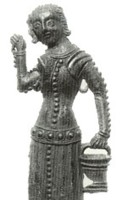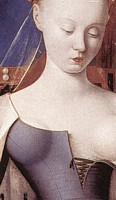|

Medieval
Buttons & Gown Lacings
BUTTONS - LACINGS - FRONT
LACING - BACK LACING - SIDE LACING
 Kirtles
and gowns closed either one of two ways- with buttons or with
lacing. Some closed at the front, others at the side seams depending
on what the garment was used for and whether it was an overgarment
or worn underneath. By the mid 13th century, buttons were in everyday
use for clothing, although the materials they were made from and
the number of them on any one garment varied greatly. Kirtles
and gowns closed either one of two ways- with buttons or with
lacing. Some closed at the front, others at the side seams depending
on what the garment was used for and whether it was an overgarment
or worn underneath. By the mid 13th century, buttons were in everyday
use for clothing, although the materials they were made from and
the number of them on any one garment varied greatly.
Some illustrations show buttons from wrist to elbow or right up
the back of the upper arm. Buttons were usually set very closely
together. Seen at right is a pewter badge of a woman and bucket
from the late 14th century from London. The buttons down the front
of her kirtle and the entire length of her sleeves are clearly
visible.
I am a little doubtful that
a milkmaid would have worn an outfit with as many buttons up the
arms as it seems excessive for the social status of the wearer.
The belt, also seems to be indicative of an upper class woman,
so the bucket is a bit of a mystery to me, although the badge
is often refered to as "a milkmaid" perhaps it is a
saint.

Buttons
Buttons down the front of a lady's kirtle could be made from matching
cloth of the gown they were intended for or of metal or semiprecious
stones set into metal clasps.  Cloth
buttons were almost always ball-shaped. As with almost every other
aspect of medieval clothing, it depended on what occasion the
gown was to be worn and who was wearing it. Cloth
buttons were almost always ball-shaped. As with almost every other
aspect of medieval clothing, it depended on what occasion the
gown was to be worn and who was wearing it. 
Lower classes would have to be content with matching cloth buttons,
while the upper classes would have preferred yet another chance
to display their social superiority on their clothing with metal
buttons.
Above left is a beautiful
example of a late 14th century tin button with glass stone set
into it. It has a shank and is from the collection at the Museum
of London.  Above
right is pictured a round, gold button from the 10th century which
also looks similar to the Uppsala Gown buttons. Above
right is pictured a round, gold button from the 10th century which
also looks similar to the Uppsala Gown buttons.
Shown at right is a garment
fragment from the 1400s from the Museum of London showing the
sleeve and cloth buttons. Unlike modern buttons, they were set
at the very edge of the garment opening and not set in from the
seam like today. Flat, modern buttons with two or four holes drilled
right through seem to be unworn at that time.

 Lacings Lacings
In medieval clothing terms, the word lace refers to lacing,
like our modern shoe-lacing, not of fancy, frilly lace. Lace was
used extensively to close gown fronts, in some cases, sides and
only in two cases that I know of on sleeves.. Lacings were also
used by men to attach hose and for arming, which we won't look
at here.
Until the 15th century, lacings were coloured to match the gown
or kirtle it was worn on, thus making the closure fairly invisible.
15th century Italy led the way in leaving gowns unlaced widely
across the bust, and at this time, lacing cords were often an
entirely different colour to the dress as it was now a feature
of the dress, not merely a way to fasten it closed.
Cord produced on a lucet produced a square braid or lace.
This lace was strong, durable and didn't easily slip when used
for garment fastenings. Many other braids and laces are made using
the fingerlooping method- that is a method of looping the thread
around the fingers to form a kind of knotted braid. Plaiting or
braiding is also another method of making laces for clothing or
shoes.

Front
lacing
 Front
lacing on kirtles and gowns can be seen abundantly in paintings.
Many images of the Madonna breastfeeding show the front of her
kirtle unlaced. Shown at left is a detail from Bouquet'sVirgin
and Child Surrounded by Angels, dated 1450. Other images which
show front lacing gowns on noble women are the 1387 Bearosin
Getting Engaged detail at right from a Prague manuscript and
the Kathryn de Mortimer funeral effigy. Front
lacing on kirtles and gowns can be seen abundantly in paintings.
Many images of the Madonna breastfeeding show the front of her
kirtle unlaced. Shown at left is a detail from Bouquet'sVirgin
and Child Surrounded by Angels, dated 1450. Other images which
show front lacing gowns on noble women are the 1387 Bearosin
Getting Engaged detail at right from a Prague manuscript and
the Kathryn de Mortimer funeral effigy.
Lacing holes seem to be very close set to avoid gaping on the
front of the dress. Lacing eyelets seem to be closely set, around
2cm.
An upper-class
woman's under-dress would almost certainly be laced. A buttoned
dress under another buttoned overgown would not only be uncomfortable
but cause unsightly lumps down the front of the outer layer. A
snugly laced under-kirtle provides a solid foundation to support
the woman's figure and to prevent the outer garment's bottons
from tearing from strain.
A working class women would have been likely to wear a front-lacing
kirtle, as she would be able to dress herself relatively quickly
and without assistance.

 Side
lacing Side
lacing
Side lacing on garments can be seen on images of young mothers-to-be.
The ability to loosen a garment at the side seams to accommodate
an expanding stomach and then pull it tight again after the birth
of a child, made special maternity clothes unnecessary.
There are many
images which show side lacing on domestic garments also. Side
lacing has the benefit of the seam becoming almost invisible and
giving a smooth look to the front and back. Many modern dresses
from the 20th century have invisible side zips for the same reason.
In the manuscript shown at the right, we see a side-laced pink
gown and in a 15th century painting by Van der Weyden, we again
clearly see a side-lacing on a woman mourning Christ on the cross.

Back
lacing
Many books on historical costuming, including Herbert Norris's
Medieval Costume and Fashion and Dion Clayton Calthrop's
English Costume cite back lacing in the early medieval
period. There are no surviving garments which support this, and
the idea that the lacing is at the back is possibly due to images
in art having no front lacing or buttons visible.
My thought is that the lacing wasn't shown or was laced in the
side seam, making it essentially invisible.

Copyright
© Rosalie Gilbert
All text & photographs within this site are the property of
Rosalie Gilbert unless stated.
Art & artifact images remain the property of the owner.
Images and text may not be copied and used without permission
|